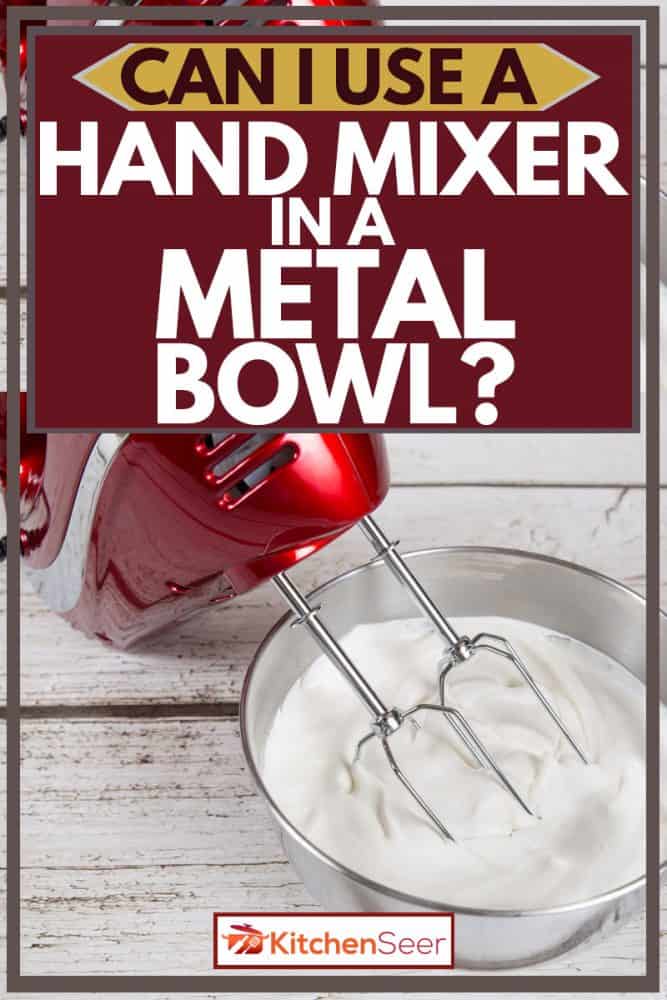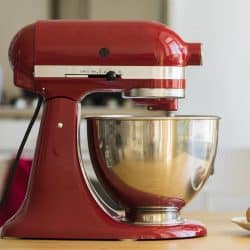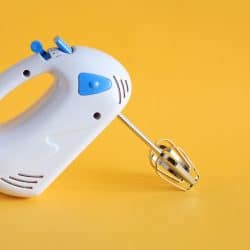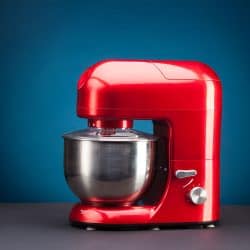 You’re preparing a cake or another dessert and all you have handy for mixing is a metal bowl. With the ingredients mostly stirred, you plug in your hand mixer, but something gives you pause. Is it safe to use a hand mixer in a metal bowl or will the metal attachments scrape and even chip off the metal in the bowl?
You’re preparing a cake or another dessert and all you have handy for mixing is a metal bowl. With the ingredients mostly stirred, you plug in your hand mixer, but something gives you pause. Is it safe to use a hand mixer in a metal bowl or will the metal attachments scrape and even chip off the metal in the bowl?
Most metal bowls should be safe to use with your hand mixer, although some bakers have reported tiny metal shavings scraping off and getting into food. If you must use a metal bowl, stainless steel is the best pick. It’s the most durable and thus the least likely to scratch or scrape when in contact with metal whisks, beaters, or other attachments.
What if you have a glass or a plastic mixing bowl instead? Are you still safe with a hand mixer in those scenarios? In this guide, we’ll discuss all the ins and outs of using a hand mixer with most common bowl materials so you can cook and bake safely!
Can I Use A Hand Mixer In A Glass Bowl?
After a stint with a metal mixing bowl, you bought a glass bowl and never looked back. You love how the glass never transfers odors or flavors from the prior things you bake or cook. Your glass bowl can also stand up to cold freezer temperatures or hot oven temperatures without melting or cracking.
Until now, you’ve always stirred ingredients in your glass bowl by hand, but this time, you’re in a rush. If possible, you’d like to use your electric mixer, but will the metal attachments destroy the glass bowl?
If you operate the hand mixer properly, then no, you shouldn’t have to worry about cracking the bowl with the attachments. The only exception is if you’re feverishly whipping ingredients such as egg whites until they’re light and foamy.
Since you need to run the hand mixer at such a high speed and glass bowls don’t necessarily have the best grip, there’s a decent chance the bowl can slip from your hand.
The quick movements of the hand mixer can send the bowl flying. Not only do your ingredients splatter all over the place, but the glass shards spread across the kitchen and possibly into other rooms of the house. You’re then in a very dangerous predicament.
To stay on the safe side, only use a hand mixer on lower speeds with a glass bowl unless yours has grips on the sides or the bottom. This set of six glass mixing bowls from Umite Chef on Amazon fits the bill. Not only is it an Amazon’s Choice product, but you get six bowls from 1.5 quarts to 7 quarts with grips. Each is color-coded for easy organization, too!
Click here to see more on Amazon.
For more on the basic mixing bowls you need in your kitchen, don’t miss our article: How Many Mixing Bowls Do You Need?
Can I Use A Hand Mixer In A Plastic Bowl?
Perhaps you haven’t updated your mixing bowls in a while, and all you have in your kitchen cabinets are plastic bowls. These have worked just fine for many cooking and baking applications, but what about using your hand mixer?
There are a few dicey issues you’ll want to look out for. First, make sure the sides of the bowl are tall enough that your cake mix or marinade can’t splash out when mixing. Like with glass, there’s also a risk that your plastic bowl can slip unless it has grips at the sides or bottom.
We like Vremi’s three-piece set of plastic mixing bowls on Amazon. Each has color-coded sides and a non-slip bottom so your bowl won’t leave the counter until you’re ready for it to.
Click here to see more on Amazon.
Plastic won’t shatter like glass even if the bowl does tip off the counter. The material may be more susceptible to scratches from metal hand mixer attachments, though. Make sure you mix uniformly around the whole bowl rather than focusing your stirring on one particular side to avoid scratching and scuffing up the bowl.
Undoubtedly, the biggest risk associated with using plastic mixing bowls or other kitchenware is toxins like bisphenol A. More commonly referred to as BPA, significant ingestion could potentially contribute to heart disease, impotence in men, and even issues with a woman’s fertility.
Make sure you always double-check that your plastic mixing bowls and other plastic products are labeled as BPA-free. Otherwise, don’t buy them.
What Should You Not Mix In A Metal Bowl?
The material you choose for your kitchen mixing bowls shouldn’t come down purely to personal taste. You also have to consider the bowl’s reactivity. Some materials will interact with what you put in them, which can lead to the bowl becoming odorized or stained.
In some instances, the food is affected, too. Its color may be altered, its flavor can lessen, or it may have an awful metallic taste.
If you have a metal bowl in particular, here are the foods and ingredients you want to avoid using in that bowl.
Vinegar
If you’ve opened the bottle and smelled it, then you know vinegar is highly acidic. Those properties lead it to react to metal bowls quite poorly, including stainless steel.
You’re much better off using a glass or ceramic bowl instead. Plastic is appropriate for very short-term storage, such as a few minutes before you serve a salad to your family.
Whipped Foods
Like we explained in the intro, there’s a possibility that very cheap metal bowls could shed small metal shavings if you whip them with a hand mixer often enough. You’ll certainly taste these shavings if they’re plentiful enough, as your food will have a metallic flavor. Try any gripped bowl not made of metal when whipping.
Tomatoes And Other Acids
The high acidity of tomatoes and citrus fruits will react poorly with a metal bowl, much like vinegar. You may notice all your future cooking always tastes faintly of oranges or tomatoes, plus, your metal bowl may be tinted. Stick with glass bowls or ceramic for acidic fruits and veggies. Some stainless steel bowls may not be as reactive if you must use metal.
Fruit
Even non-acidic fruits you might bake with are not recommended for use with a metal mixing bowl. The absorbent qualities of fruits means they can suck up flavor residue from your previous baking and cooking adventures in the metal bowl. The flavor of your dessert might taste a bit off, then. Try glass or ceramic bowls instead.
In Closing
Metal bowls are considered reactive, meaning you must limit your use to non-reactive foods and ingredients only. Anything acidic is a no-no, as are some fruits.
Using a hand mixer in a metal bowl should be okay unless yours is very cheap or old. Then, tiny metal shavings could come off if you mix long enough. Stainless steel bowls may be less likely to chip like this, and you don’t have to worry about the issue at all with glass or plastic bowls.
Don't miss these other helpful kitchen guides:








